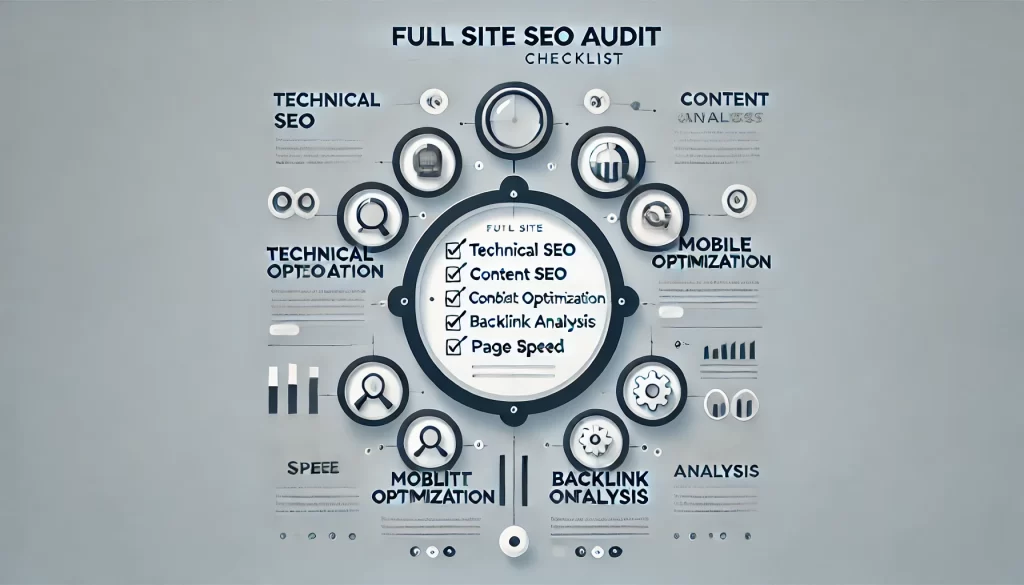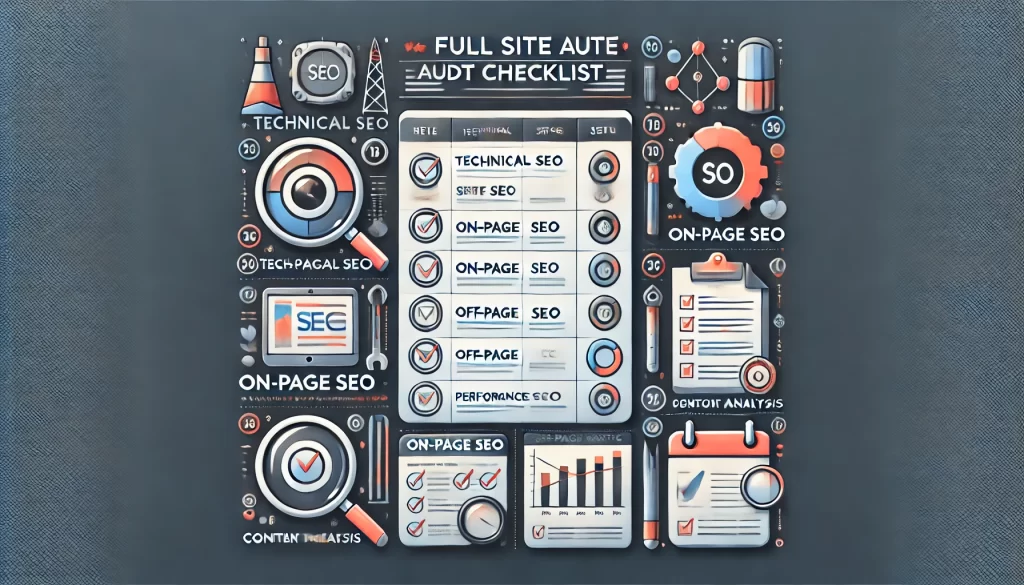A full site SEO audit is a comprehensive analysis of a website’s performance in search engines. Unlike a basic SEO check, a full audit examines technical SEO, content quality, backlinks, user experience, and more.
✔ Finds & fixes technical errors preventing search rankings
✔ Optimizes content for better search visibility
✔ Improves site speed, mobile usability, and overall performance
If your rankings have dropped or your website isn’t performing as expected, a full site SEO audit is the best way to identify & fix the underlying issues.

What Does a Full Site SEO Audit Include?
A complete SEO audit examines five key areas:
1. Technical SEO Audit
✔ Crawlability & indexing errors
✔ Page speed & Core Web Vitals
✔ HTTPS security & mobile usability
2. On-Page SEO Audit
✔ Title tags, meta descriptions, and header structure
✔ Keyword optimization & internal linking
✔ Duplicate & thin content detection
3. Content Audit
✔ Blog & landing page keyword relevance
✔ Content depth, readability & engagement metrics
✔ Search intent alignment
4. Backlink & Off-Page SEO Audit
✔ Domain authority & backlink quality
✔ Toxic link detection & disavow analysis
✔ Competitor backlink gap analysis
5. User Experience (UX) & Mobile Optimization
✔ Bounce rate, dwell time, & CTR analysis
✔ Navigation structure & site architecture
✔ Mobile-friendly design & responsiveness

Suggested Posts:
• Technical SEO Audits
• What is SEO Site Audit?
• Recover from Google Penalties
How to Perform a Full Site SEO Audit (Step-by-Step Guide)
Step 1: Website Crawl & Indexing Analysis
🔹 Use Google Search Console to check for indexing errors
🔹 Run a full site crawl with Screaming Frog
🔹 Fix 404 errors, broken links & duplicate content
✅ Fix: Update the XML sitemap & robots.txt file
Step 2: Page Speed & Core Web Vitals Optimization
🔹 Use Google PageSpeed Insights to analyze performance
🔹 Optimize image compression, caching, and minify CSS/JS
✅ Fix: Improve mobile load times & server response speed
Step 3: On-Page SEO & Metadata Optimization
🔹 Optimize title tags, meta descriptions, and headers
🔹 Use SEO-friendly URLs & improve internal linking
✅ Fix: Ensure all pages have unique & optimized metadata
Step 4: Backlink & Domain Authority Audit
🔹 Use Ahrefs or Moz to check the backlink profile
🔹 Disavow spammy links & build high-authority backlinks
✅ Fix: Focus on high-quality link-building
Step 5: UX & Mobile Optimization Check
🔹 Test site on Google’s Mobile-Friendly Test
🔹 Improve navigation, readability, and layout shifts
✅ Fix: Ensure responsive design & mobile usability
How Often Should You Conduct a Full Site SEO Audit?
| Audit Type | Recommended Frequency |
| Basic SEO Audit | Every 3-6 months |
| Full Site SEO Audit | Every 6-12 months |
| Backlink Audit | Every 6 months |
🔹 If rankings drop, run an audit immediately!
Suggested Posts:
• Ecommerce SEO Audit
• E-Commerce SEO Audit
• Optimize Ecommerce Voice Search
Best Tools for a Full Site SEO Audit
✅ Google Search Console → Indexing & site errors
✅ Google PageSpeed Insights → Speed & performance check
✅ Screaming Frog SEO Spider → Full site crawl
✅ Ahrefs / Moz → Backlink & keyword analysis
FAQs About Full Site SEO Audits
How long does a full SEO audit take?
Small sites: 3-5 days, Large sites: 1-2 weeks.
Can I do a full SEO audit myself?
Yes! Free tools like Google Search Console help, but professional audits provide deeper insights.
What’s the most important part of a full SEO audit?
Technical SEO, content quality, and backlink profile.
Key Takeaways
Why Full-Site SEO Audits Are Essential
✔ A full site SEO audit ensures all technical, content, and backlink issues are fixed.
✔ Websites should undergo a full audit every 6-12 months.
✔ Investing in professional SEO audit services ensures better rankings & site performance.
Want to improve rankings? Start with a full site SEO audit today!
Next Step?
Need a professional full-site SEO audit for your website?📩 Request a Free SEO Audit
